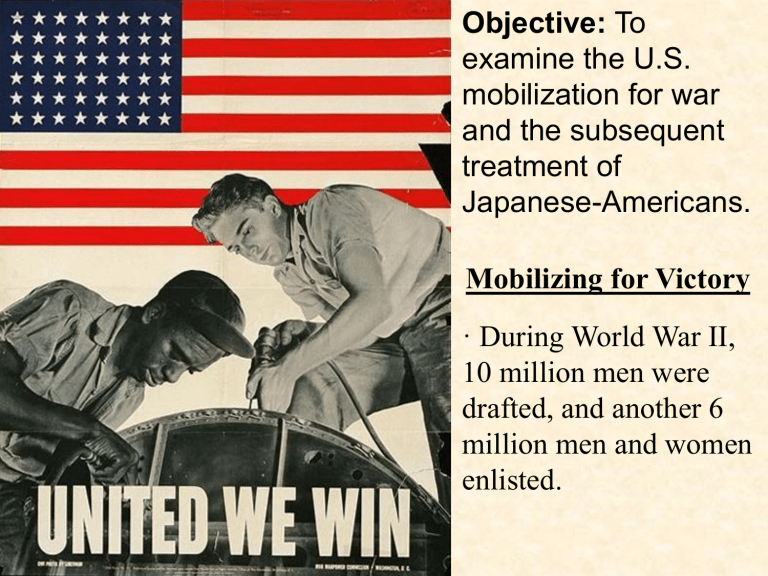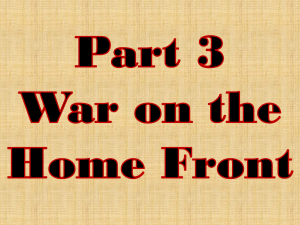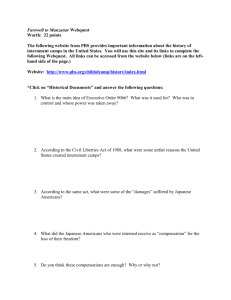Relocation of Japanese Americans

Objective: To examine the U.S. mobilization for war and the subsequent treatment of
Japanese-Americans.
Mobilizing for Victory
· During World War II,
10 million men were drafted, and another 6 million men and women enlisted.
· The government controlled the economy as it did during World War I.
Examples:
- the government set prices and rationed scarce goods
- the War Production
Board helped factories to produce war goods
· Consumers faced a shortage of goods due to the war.
Examples:
- Many items, such as fuel and sugar, were rationed during the war.
- No new cars were produced after 1942.
The wartime demand for goods ended the Great Depression and unemployment fell.
New Roles for Women
· There was an urgent need for women to enter the workforce to help with the war effort and to keep the nation’s economy going.
· Over 6 million women entered the workforce, replacing men that joined the military.
1942: a woman grinds the points on drills, and the drills will be used in the war effort.
· “Rosie the Riveter” symbolized the millions of women that worked in factories producing planes, tanks, ships, and other war goods.
· Women enjoyed a newfound confidence in their ability and right to work outside of the home and many began to earn salaries equal to men.
We Can Do It!
Rosie the Riveter
Artist: J. Howard Miller
“Rosie the Riveter”
Lyrics by Redd Evans and John Jacob Loeb, 1942
All the day long,
Whether rain or shine,
She's a part of the assembly line.
She's making history,
Working for victory,
Rosie the Riveter.
Keeps a sharp lookout for sabatoge,
Sitting up there on the fuselage.
That little girl will do more than a male will do.
Rosie's got a boyfriend,
Charlie.
Charlie, he's a Marine.
Rosie is protecting Charlie,
Working overtime on the riveting machine.
When they gave her a production "E,"
She was as proud as she could be.
There's something true about,
Red, white, and blue about,
Rosie the Riveter.
Relocation of Japanese Americans
· After the attack on Pearl Harbor, many Americans questioned the loyalty of Japanese Americans, fearing they may act as spies or help Japan invade the U.S.
We're gonna have to slap the dirty little Jap
And Uncle Sam's the guy who can do it
We'll skin the streak of yellow from this sneaky little fellow
And he'll think a cyclone hit him when he's thru it
We'll take the double crosser to the old woodshed
We'll start on his bottom and go to his head
Performed by Carson Robison, December 1941 – audio link
When we get thru with him he'll wish that he was dead
We gotta slap the dirty little Jap
We're gonna have to slap the dirty little Jap
And Uncle Sam's the guy who can do it
The Japs and all their hooey will be changed into chop suey
And the rising sun will set when we get thru it
Their alibi for fighting is to save their face
For ancestors waiting in celestial space
We'll kick their precious face down to the other place
We gotta slap the dirty little Jap
The Wartime
Relocation
Agency
(WRA) forced approximately
120,000
Japanese
Americans to…
…sell their homes and businesses,
and relocate to inland camps, living in crowded barracks behind barbed wire.
• They were released in
1944, after victory against the
Japanese seemed imminent.
Internment camp in
Manzanar,
California
Japanese American Internment
(U.S. Govt Propaganda)
(9:26)
Kenji - Manzanar (3:51)
This is a video to the song
"Kenji" by Fort Minor, or
Mike Shinoda of Linkin Park.
It describes his family's life in the time of World War II and how they were put in a
Japanese Internment Camp.
Effects used in this make it seem as though the video was actually from 1942.









